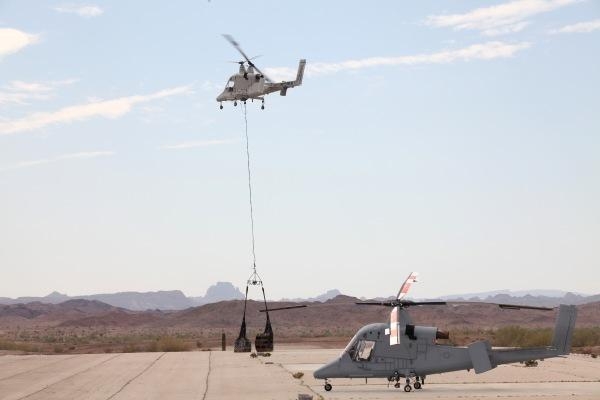Thu, Sep 08, 2011
Lockheed Martin/KAMAN Demonstrate Autonomous Resupply
Capabilities
A five-day Quick Reaction Assessment (QRA) for the U.S.
Navy’s Cargo Unmanned Aircraft Systems (UAS) program has been
successfully completed by the Lockheed Martin-led unmanned K-MAX
team.

“The autonomous flying K-MAX is designed to resupply
Marines on the battlefield and in remote locations,” said
Roger Il Grande, director of Airborne Systems at Lockheed Martin
Mission Systems & Sensors. “Through various scenarios
during QRA, the unmanned K-MAX UAS performed extremely well,
exceeding the cargo delivery objectives of the
assessment.”
The U.S. Navy awarded Lockheed Martin a $45.8 million contract
in December 2010 for unmanned K-MAX helicopters to perform in a
U.S. Marine Corps evaluation of unmanned cargo resupply. The Navy
intends to field a Cargo UAS this fall for a six-month deployment
to augment Marine Corps ground and air logistics operations in
Afghanistan. "The Quick Reaction Assessment proved sustainment of a
cargo-carrying capability in an operational environment” said
Capt. Patrick Smith, Cargo UAS program manager at the Navy’s
Patuxent River, Md., facility. "We look forward to deploying a
capability that will supplement rotary wing assets and reduce
Marine Corps exposure to improvised explosive devices in
theater."
A formal report will be released by Commander Operational Test
and Evaluation Force (COMOPTEVFOR) 30 days post completion of QRA.
Results will be reviewed by Navy and Marine Corps leadership to
determine the system’s suitability for deployment.
In July, the unmanned K-MAX successfully completed
Electromagnetic Environmental Effects (E3) testing at Pax River.
The purpose of the E3 testing was to measure and provide results
regarding the aircraft's electromagnetic susceptibility to certain
frequencies, which can affect flight-critical and other systems on
the aircraft. “Since partnering in 2007, Lockheed Martin and
Kaman Aerospace have successfully transformed Kaman’s proven
K-MAX power-lift manned helicopter into a UAS capable of autonomous
or remote controlled cargo delivery,” said Terry Fogarty,
general manager, UAS Product Group at Kaman Aerospace.
More News
Aero Linx: Model Aeronautical Association of Australia MAAA clubs are about fun flying, camaraderie and community. For over 75 years, the MAAA has been Australia’s largest fl>[...]
Touchdown Zone Lighting Two rows of transverse light bars located symmetrically about the runway centerline normally at 100 foot intervals. The basic system extends 3,000 feet alon>[...]
“Discovery and innovation are central to our mission at Virgin Galactic. We’re excited to build on our successful record of facilitating scientific experiments in subor>[...]
How To Get A Story On Aero-TV News/Feature Programming How do I submit a story idea or lead to Aero-TV? If you would like to submit a story idea or lead, please contact Jim Campbel>[...]
Student Pilot Reported That During Rotation, “All Of A Sudden The Back Of The Plane Kicked To The Right..." Analysis: The student pilot reported that during rotation, “>[...]
 ANN's Daily Aero-Linx (05.02.24)
ANN's Daily Aero-Linx (05.02.24) ANN's Daily Aero-Term (05.02.24): Touchdown Zone Lighting
ANN's Daily Aero-Term (05.02.24): Touchdown Zone Lighting Aero-News: Quote of the Day (05.02.24)
Aero-News: Quote of the Day (05.02.24) ANN FAQ: Contributing To Aero-TV
ANN FAQ: Contributing To Aero-TV NTSB Final Report: Cirrus Design Corp SR20
NTSB Final Report: Cirrus Design Corp SR20



